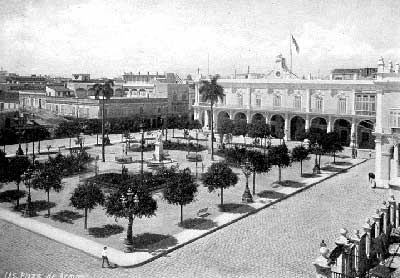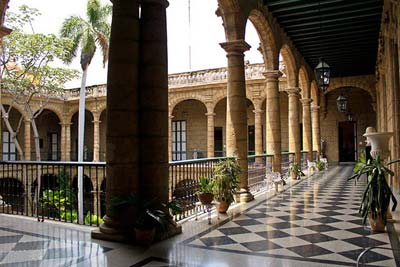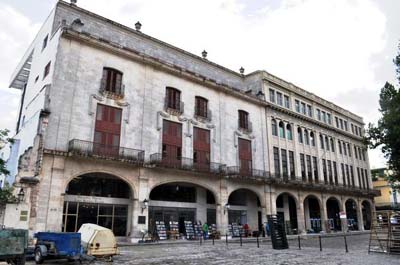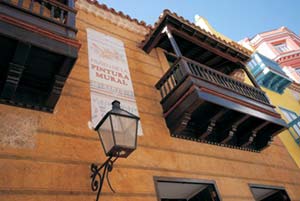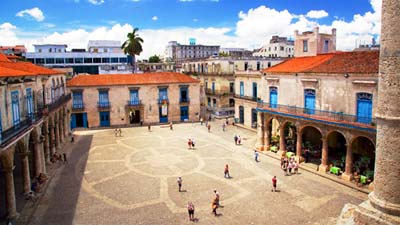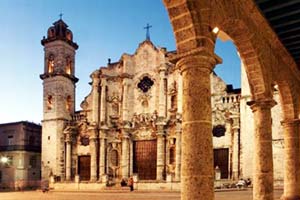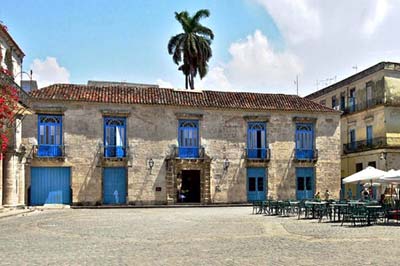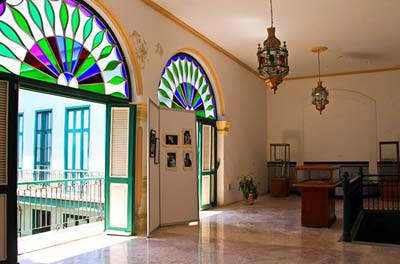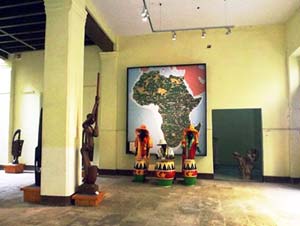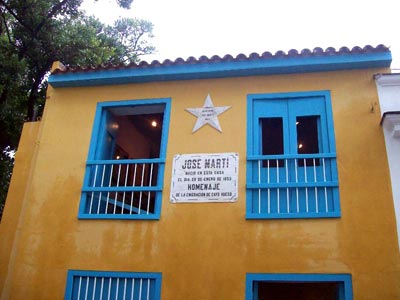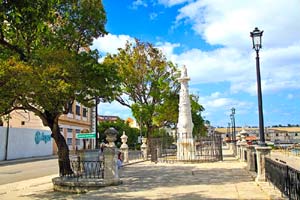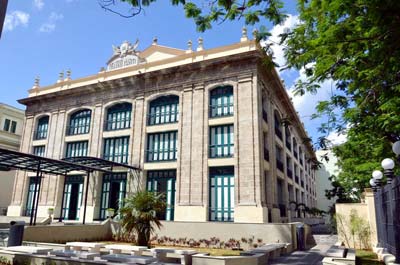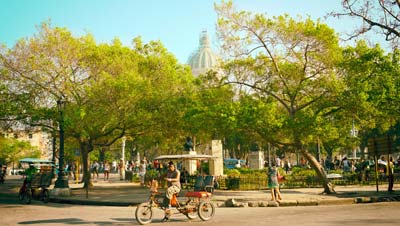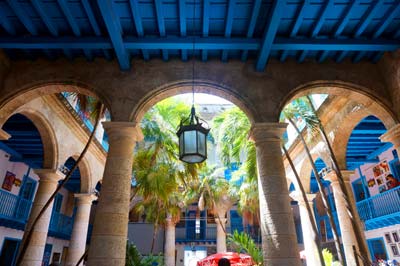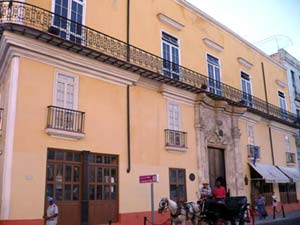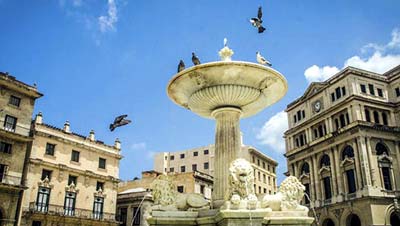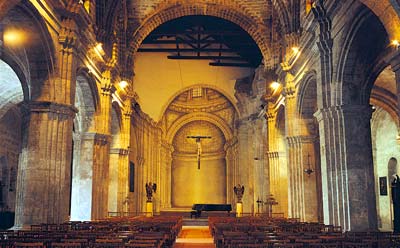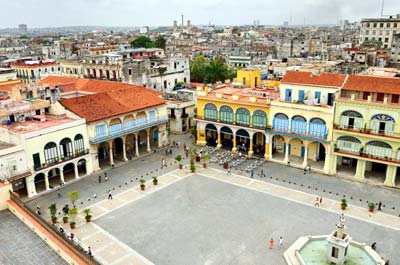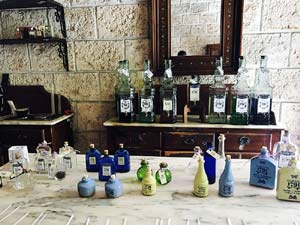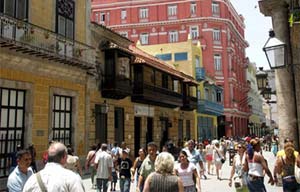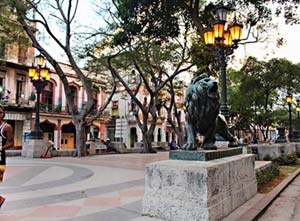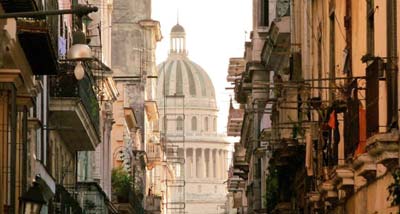Looking for a casa particular in Old Havana? Take a look here, you'll find the complete list of what we're offer.
Essential and Ultimate Guide to Old Havana
The goal of this guide, which will be bigger and bigger over the time, is to describe the monuments and the most important places of cultural interest in Old Havana. In this guide we will not talk about places which belong to Centro Habana borough, not even those located in the limit of both, except for the case of the Capitol. Each place or monument will be briefly described here, and some places have an associated article, but not all of them.
Although this guide will not cover absolutely everything related to Old Havana it is possible that over the time new items will be added to this guide, whose final goal is to be exhaustive in the limits of the possible.
But let begin with the ultimate guide!
The Real Force Castle (El Castillo de la Real Fuerza)
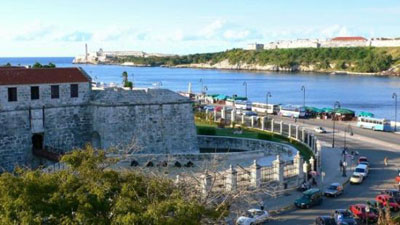
The Real Force Castle is one of the most ancient monuments in the city, it was built during the colonial epoch in defense of the city, it is part of Plaza de Armas (or Plaza de Armas is part of it). During its time it was a military fortification. Today it is a museum and it contains objects related to navigation history and the naval construction in Cuba.
El Templete
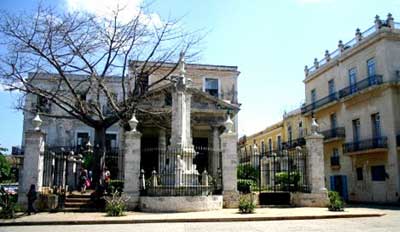
The Templete is a small temple issued to celebrate the foundation of the city of the Havana. It was in this very place where the first mass and chapter took place in Havana. Today the placed is visited for this exact reason and it is also linked to a tradition, each year on November 15 (the day before the foundation of the city), thousand of people goes there to ask blessings and chance.
The Templete is located at the left of the Real Force Castle at the north side of the Plaza De Armas, just close to the Santa Isabel Hotel. There is a classical restaurant having the same name, it is located in face of the Marinerito, in the Malecon, very close to Plaza de Armas.
Plaza de Armas
The Plaza de Armas is the oldest place in Havana; it was there where the city was initially founded. Its architecture is the same than the fortified place during Middle Age Europe. It was there where the colonial authority headquarters were located, as well as the Iglesia Parroquial of the city.
Museum of the City
The Museo de la Ciudad (Museum of the City) is now located in the magnificent Palacio de los Capitanes Generales, the former colonial authority headquarter in Cuba. It also was a Presidential Palace. This museums expresses one of the Havana general visions from its foundation to now.
National Museum of Natural History
The museum is located in the popular Plaza de Armas and it is a scientific and cultural place where its people collect, investigate, conserve and exhibit several natural objects with the aim to to promote scientific and cultural knowledges of nature. It was founded in 1960 and it's located in Obispo at the corner of Oficios streets. It opens on Tuesday from 1 PM to 5:30 PM and from Wednesday to Sunday from 9:30 AM to 5:30 PM.
Museum of Mural Painting
Another important museum that is found around Plaza de Armas. Its address is Obispo between Mercaderes and Oficios streets, therefore it is just aside the National Museum of Natural History. This institution has developed its own cultural project for the rescue, conservation and dissemination of Cuba's colonial artistic heritage..
The Plaza of the Cathedral
The Cathedral Plaza is one of the most beautiful and preserved places of Havana, surrounded by restored buildings with the aim to keep the original radiance. There, you can find the Cathedral of Havana where the place takes its name and you will get two monuments in one.
The Cathedral of Havana
It's the most important monument in Cuban Baroque architectonic style. It's located in the place that takes its name. The major effect of this cathedral is that the façade is very decorated and the inner walls are quite sobers, while the two towers has an austere and plane surface. During its history it suffered from several modifications, including of neoclassical style (1814). Today is one of the most important monuments of Cuban architecture. Being restored in 1984, it is still functioning as a cathedral and several classical music concerts take place there.
Museum of Colonial Art
It's nothing more that the ancient Casa Bayona, which is located precisely in face of the Cathedral of Havana and it is characterized by a palm in its patio that, seen from the outside creates a unique contrast, from which it takes its popularity.
The museum was inaugurated in the year 1969, reaching two important goals: preserving an important historical-architectonic monument and preserving the heritage of the Old Havana colonial past. Its visit is a must if you really want to know Havana from the inside.
The museum features four exposition halls, three of which are permanent (its contents doesn't change over time), and the fourth is transitory, that is, it may expose objects related with the estate theme or with funds of the institution.
Arabs Museum
It's about an absolutely singular museum in Old Havana, its purpose is to divulge the Arabs values from the artistic, cultural and architectonic points of views. It was inaugurated on November 16, 1983. The Arabs Museum is located in the Oficios street between Obispo and Obrapía and it's open from Tuesday to Saturday from 08:30AM to 04:30 PM. In front of it, you can find a quite important mosque.
Museum of Africa
Another absolutely singular museum, this time devoted to Africa in general. It is located in the historical center of Old Havana with a comprehensive collection of African objects, unique of its type in Cuba. Founded in January 6, 1986 it's located in the 157 Obrapía street between Mercaderes and San Ignacio and it's open from Tuesday to Saturday, from 9:30 AM to 5 PM.
José Martí Birthpalce Museum
José Martí is the national apostle of Cuba, he was a writer, journalist and intellectual during the era of independence wars against Spain. He played a big patriotic role and he's mentioned in the Constitution of the Republic of Cuba, as an ideological guide, as well as political and social model, considered the symbol of the Cuban struggle for national freedom and the intellectual author of the Cuban Revolution and the biggest exponent of the independent spirit of Cuba.
The native house of José Martí museum is located in Old Havana. As a museum it was founded in January 1925, long before the Cuban Revolution took place, and it shows the works of Martí as a politician, intellectual and writer.
The museum offers guided visits, courses and martian reading, monthly exhibitions, video watching and concerts. It is one of the most visited places by tourists and it's located on Leonor Pérez street between Picota and Egido.
Carlos J. Finlay National Museum of Science and History
It was founded in 1874 and, before that, it was the headquarter of Cuban Science Academy. It contains a library with more than 50 thousand books, several documents and manuscripts by important Cuban scientists.
The museum is located on Cuba street between Teniente Rey and Amargura.
San Francisco de Paula Church
It was a hospital of women and hermit place in 1664. It was destroyed by a hurricane in 1730 and then rebuilt again in Baroque style to fulfill the same function. In 1907, it was a private property and the owners decided to demote it in 1937, but, after strong pressure by intellectuals of that epoch, only the hospital was finally demoted in 1946. A good portion of the church remained and today it is a legacy of significant values. It is also a concert hall.
Alameda de Paula Avenue
One of the most characteristic place of the historic center Malecon, at the harbour location. It was one of the boulevards of Old Havana. It had a fountain, but this one was destroyed in 1910.
The Martí Theater
Another of the most important monument in the historical center. Aside from being a theater, it also was the place where important Cuban historic agreements were made. It was restored and today it works mainly as a concert hall. It is located on the corner of Zulueta and Dragones streets.
Central Park
One of the most emblematic places of Old Havana, surrounded by hotels and important avenues. It's facing the hotel of the same name and it also faces the Telegrafo and Inglaterra hotels.
Park of Fraternity
Another of the major parks in Old Havana, close to China Town. Today it's simply a transit place where several collective taxis are located. It faces the Computer Palace and it separates the Reina and Monte avenues.
The Revolution Museum
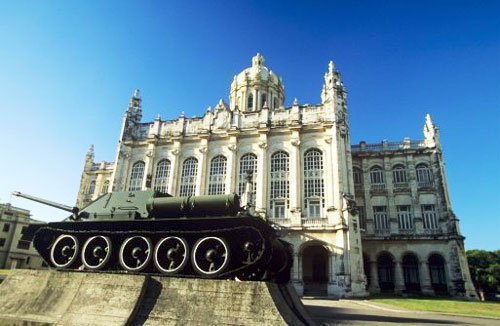
The Cuban Revolution is full of history and legends and it was a subject of unquestionable international interest. In the Revolution Museum which is located between the avenues Zulueta and Monserrate you can find almost everything related to the Cuban Revolution including the remaining of the Granma yacht rided by Fidel Castro, Che Guevara and other revolutionaries to reach Cuba from Mexico, when the Revolution began.
In this same building it's also located an important art museum.
Fine Arts Museum
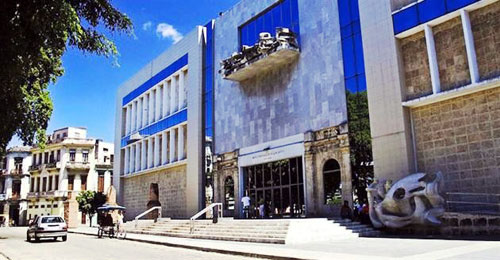
It is located very close to the Manzana de Gómez and it contains the most featured art works of Havana.
Hand Craft Palace
At the beginning, it was called the Casa Mateo Pedroso, finished in 1780 and restored in 1938. It is today one of the most featured places in Old Havana. It's now named Palacio De La Artesanía or Hand Craft Palace.
Museum of Music
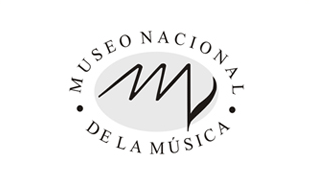
It is located near the entry of the Havana Bay tunnel. It contains many relics of musical instruments, manuscripts and other objects belonged to important Cuban musicians.
Museum of Rum
One of the specialities of Cuba is the rum drink. For this, you can find in Old Havana a Museum of Rum where you'll have the opportunity to experience the first hand rum elaboration process and where you can also taste it. As well you can learn the history of the Cuban rum and many other very interesting things related to this topic.
Pigeon's Plaza
Officially called Plaza de San Francisco de Asís and popularly known as Plaza de las Palomas (Pigeon's Plaza), is an imposing place, one of the most important in Old Havana. It faces the Lonja del Comercio (Business Lounge), an important business centre of the capital city, aside the El Café del Oriente famous restaurant, where the historian of Havana, has, by tradition, a permanent reserved table.
From the other side of Plaza de las Palomas you can find the great church of San Francisco de Asís. And, obviously, the place is all the time full of pigeons and it's one of the photographer's favorite places.
San Francisco De Asís Church
It was built between 1719 and 1738 and it's a church and a convent at the same time. One of the most important monument of the Colonial epoch. It was recently restored and it became a concert hall.
Plaza Vieja (Old Plaza)
Contrary to one's possible belief, the Plaza Vieja (Old Plaza), isn't one of the first places built in Old Havana. Instead, it has represented an attempt to enlarge the city in answer of the urban development. And ironically, at the beginning it was called Plaza Nueva (New Plaza)!
Today the Plaza Vieja is one of the most loved places because of its multiple attractions. In fact, in the Old Plaza there is the National Planetarium, the House of Beer, the Escorial Coffee and the only Paul & Shark shop of Havana city.
The Planetarium of Havana
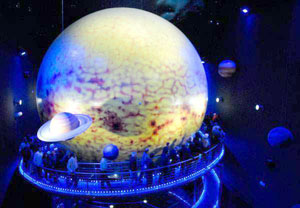
It is located in Plaza Vieja. Built initially as an extension of the Air Museum on December 21, 1999, the planetarium is today a totally independent place and it's divided in several floors, it features a reconstruction of the solar system with scaled planets and its movements. It also features an interactive zone and it has even an astronomical observatory.
The Oswaldo Guayasamín House Museum

Oswaldo Guayasamín was a featured Equatorian painter, famous for its paint of Fidel Castro's hands. Havana city has a museum dedicated to him and it is precisely located in Old Havana. Obviously, you will not find all the Guayasamín's works here, because the artist was not Cuban, but you'll find all the objects the artist donated to the Cuban nation, some of them being unique exemplaries. The museum is located in the Obra Pía street between Oficios and Mercaderes.
The Bacardi Building

It was the highest building of Havana and it's built with marbles of all nations of Europe. It hosted the offices of the Bacardi company, which was elaborating and bottling the rum that today is called Havana Club. It's located at the corner of the Monserrate and San Juan de Dios streets, obviously in Old Havana. After the Cuban Revolution triumph, the Bacardi company moved in the United State and today, the building host several offices of foreign companies and it also featured a restaurant in the first floor. In the year 2001, the building was restored thanks to an Italian company and today it keeps all the original decoration, as well as the exterior of the building. One of the most curious things about that is the presence, in the roof, of a sculpture in form of bat.
Museum of Perfume
It's one of the most interesting museums in Old Havana. It's located on the Mercaderes street, at the corner with Obrapía. It's also known with the name of Habana 1791, as suggested by Eusevio Leal, historian of Havana. One of the most impressive characteristics is that the museum elaborates customized perfumes according to the customer's tastes. The perfume is prepared from its raw elements which are mixed using a craft style. The museum offers twelve different essences: rose, lilac, violet, tobacco, jasmine, azahar, lavender, vetiver, citric, ilhang, pachuli and sandal.
In order to elaborate a customized perfume, the customer gets a questionnaire where it hav to answer several questions, including age, month of birth, tastes and habits. And, starting from there, the house creates a formula according to the customer's character. During the preparation, the customer is invited to try it until he or she fells fully satisfied. And finally, the perfume is served within a small bottle, sealed with wax, including a ticket with the name of the house and a verse. Don't leave Cuba without getting it!
The Obispo Street
The Obispo is a pedestrian street, cars can't transit there. There are a lot of hotels, casas particulares, shops, restaurants, bars, craft men and painters. It's one of the more popular places in Old Havana and one of the most frequented by tourists.
The Prado Promenade
It's a very important avenue and promenade because it marks the division between the municipalities Centro Habana and Old Havana. Furthermore it has a park in the middle of the two roadways, which is the main attraction. This because it was, during the IXX century, the place where Havana aristocracy used to meet; today it's a promenade where a lot of tourist transit and where you can sometimes find craft men and painters. Its importance is also due to the fact it connects the Malecón with the Central Park, and the National Capitol with the rest of Old Havana.
The National Capitol of Cuba
It officially belongs to the Centro Habana municipality, but it's so historically associated to Old Havana that we really can say it belongs to it entirely. In fact, it is also located on the boundary between both municipalities, so it can belongs either to Centro Havana and Old Havana.
It is very similar to the Capitol in Washington. But, in Cuba, the Capitol is not the base of the government, it is simply a parlamentary seat and also a monument that played many roles in history. Its edification was started by Machado, but it had many authors, with the purpose to be the Presidential Palace, because the president of the epoch ruled from the Palacio de los Capitanes Generales in Plaza de Armas. But the Capitol never became the Presidential Palace. In spite of that, it became the base of the Constitutional Assembly, which, in 1940, enacted the famous Cuban Constitution. The Cuban Revolution converted it into the headquarters of the Academy of Sciences and the Ministry of Science, Technology and Environment, as well as the seat of Asamblea Nacional del Poder Popular (the National Assembly of People's Power, that is, the Cuba's parliament).
In the tip of its cupola there is a diamond, which marks the kilometer zero of all Cuban routes. Such diamond of 25 carats belonged to the latest Russian Zar, Nicolas II, and it reached Havana by a Turkish jeweler who bought it in Paris. However, it was stolen, then recovered, and is now preserved in the Central Bank of Cuba, with only a symbolic replica remaining in the Capitol. The Capitol is today one of the main symbols of Havana, together with the Morro Fortress, the National Hotel of Cuba and few other places.







